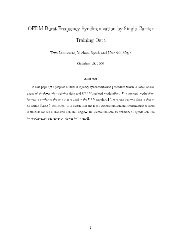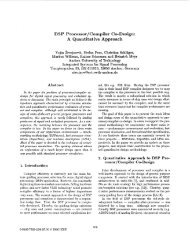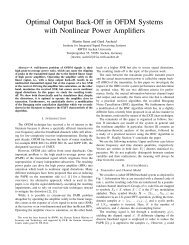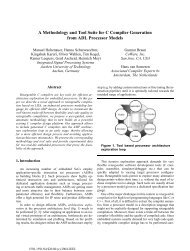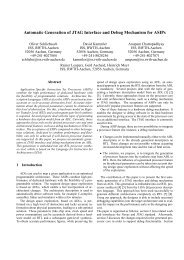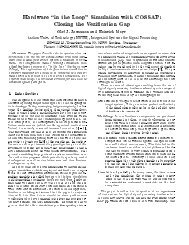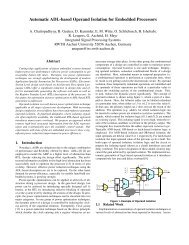supersim | a new technique for simulation of programmable ... - ICE
supersim | a new technique for simulation of programmable ... - ICE
supersim | a new technique for simulation of programmable ... - ICE
Create successful ePaper yourself
Turn your PDF publications into a flip-book with our unique Google optimized e-Paper software.
In the Proceedings <strong>of</strong> ICSPAT'95, Boston, USA, pp. 1748 {1763<br />
SUPERSIM | A NEW TECHNIQUE FOR SIMULATION OF<br />
PROGRAMMABLE DSP ARCHITECTURES<br />
V. Zivojnovic, S. Pees, Ch. Schlager, R. Weber, and H. Meyr<br />
Integrated Systems <strong>for</strong> Signal Processing<br />
Aachen University <strong>of</strong>Technology<br />
Templergraben 55, 52056-Aachen, Germany<br />
ABSTRACT<br />
This paper presents a <strong>technique</strong> <strong>for</strong> simulating<br />
DSP processors based on the principle <strong>of</strong> compiled<br />
<strong>simulation</strong>. Unlike existing, commercially<br />
available instruction set simulators <strong>for</strong> DSP processors,<br />
which are <strong>of</strong> interpretive character, the<br />
proposed <strong>technique</strong> per<strong>for</strong>ms instruction decoding<br />
and <strong>simulation</strong> scheduling at compile time.<br />
The <strong>technique</strong> oers up to three orders <strong>of</strong> magnitude<br />
faster <strong>simulation</strong>. The high speed allows<br />
the user to explore algorithms and hardware/s<strong>of</strong>tware<br />
trade-os be<strong>for</strong>e anyhardware implementation.<br />
Moreover, the user can tailor the<br />
compiled <strong>simulation</strong> to trade speed <strong>for</strong> more accuracy.<br />
In this paper, the sources <strong>of</strong> the immense<br />
speedup are analyzed and the realization <strong>of</strong> the<br />
<strong>simulation</strong> compiler is presented.<br />
I. Introduction<br />
Designers <strong>of</strong> today's DSP systems | such as digital<br />
cellular phones and multimedia systems | face<br />
rising complexity and quickly changing system requirements.<br />
To deal with these challenges, designers<br />
have increasingly turned to <strong>programmable</strong> architectures<br />
as the basis <strong>for</strong> their DSP systems. The exibility<br />
inherent insuch architectures allows designers<br />
to accommodate late design changes and to x bugs<br />
even after shipping the systems. Moreover, the exibility<br />
promises shorter design time, thus decreasing<br />
time-to-market.<br />
In the past, <strong>programmable</strong> processors played a<br />
peripheral role: they per<strong>for</strong>med control and interface<br />
functions while ASICs provided key DSP functions.<br />
Today, with the advent <strong>of</strong>much higher per<strong>for</strong>mance<br />
digital signal processors, they play amuch larger<br />
role, providing key DSP functions as well as control<br />
and interfacing, and relegating ASICs to the role <strong>of</strong><br />
accelerators. Correspondingly, the amount and complexity<br />
<strong>of</strong> DSP code have increased introducing the<br />
need <strong>for</strong> <strong>new</strong> powerful s<strong>of</strong>tware development tools.<br />
Instruction set architecture (ISA) simulators <strong>of</strong><br />
the processor, such as instruction set simulators are<br />
standard part <strong>of</strong> tool-sets supplied with o-the-shelf<br />
or in-house DSP processor. They enable com<strong>for</strong>table<br />
debugging through controlled program execution<br />
and provide visibility <strong>of</strong> processor resources necessary<br />
<strong>for</strong> code development. All currently available<br />
instruction set simulators use the interpretive <strong>simulation</strong><br />
<strong>technique</strong>. Their main disadvantage is the low<br />
<strong>simulation</strong> speed. In the sequel we shall see that this<br />
represents a serious limitation <strong>for</strong> use <strong>of</strong> ISA simulators<br />
in DSP code design and verication.<br />
This paper presents a <strong>new</strong> approach to ISA modeling<br />
that is fast enough to enable code verication<br />
and statistical exploration <strong>of</strong> algorithms without any<br />
hardware components. Instead <strong>of</strong> the standard interpretive<br />
<strong>technique</strong>, it uses the <strong>technique</strong> <strong>of</strong> compiled<br />
<strong>simulation</strong>. We have observed three orders <strong>of</strong> magnitude<br />
improvement in speed over standard interpretive<br />
simulators on some examples. Typical speedups<br />
are between one and two orders <strong>of</strong> magnitude.<br />
The <strong>new</strong> <strong>technique</strong>s is able to close the speed-gap<br />
between <strong>simulation</strong> and real-time execution on the<br />
processor to only one order <strong>of</strong> magnitude.<br />
Because <strong>of</strong> its ability to be tailored to each <strong>new</strong><br />
<strong>simulation</strong>, our compiled simulator | SuperSim |<br />
can be used in dierent kinds <strong>of</strong> <strong>simulation</strong> tasks.<br />
We can write behavioral hardware models in C and<br />
attach them using subroutine calls to the compiled<br />
simulator (i.e. behavioral <strong>simulation</strong>). We can embed<br />
our simulator within system-level <strong>simulation</strong> environments<br />
such asCOSSAP, DSPstation, Ptolemy,<br />
or SPW. This combination lets us verify algorithms<br />
using the exact arithmetic properties <strong>of</strong> the target<br />
processor (i.e. bit-true <strong>simulation</strong>). Wecanhave the<br />
simulator compiler insert code that mimic instruc-
tion pipelines. Thus we can estimate the number <strong>of</strong><br />
clock cycles that the s<strong>of</strong>tware will require between<br />
real-time events (i.e. clock-true <strong>simulation</strong>). We can<br />
connect the compiled simulator to a VHDL or VER-<br />
ILOG simulator to verify hardware that interfaces<br />
directly to simulated-processor pins. The simulator<br />
compiler achieves this by inserting code that communicates<br />
pin updates to the hardware simulator (i.e.<br />
pin-accurate <strong>simulation</strong>).<br />
Compiled <strong>simulation</strong> does not limit debugging.<br />
Our approach provides links from the compiled code<br />
to the original source program <strong>for</strong> the simulatedprocessor<br />
code. The links allow the use <strong>of</strong> a standard<br />
C-language debugger (such asdbx) onthetarget<br />
program. Thus, designers can debug the code<br />
just as they would with a vendor-supplied interpretive<br />
simulator.<br />
The compiled <strong>simulation</strong> <strong>technique</strong> weuse<strong>for</strong>our<br />
simulator is well known in <strong>simulation</strong> <strong>of</strong> hardware<br />
circuits, e.g. [1]. We follow the same general idea,<br />
but apply it to the <strong>simulation</strong> <strong>of</strong> the instruction set<br />
architecture. Our approach resembles binary translation<br />
used <strong>for</strong> migrating executables from one machine<br />
to another [2], or collecting run-time statistics<br />
[3]. However, clock/bit-true translation and debugging<br />
are not objectives <strong>of</strong> binary translation.<br />
II. Fast ISA Simulation<br />
The following three examples shall provide an insight<br />
into the role <strong>of</strong> fast ISA <strong>simulation</strong> in DSP code<br />
design, joint DSP processor-compiler design, as well<br />
as in the general model-be<strong>for</strong>e-silicon approach.<br />
DSP Code Verication<br />
On Fig. 1atypical DSP s<strong>of</strong>tware design ow is<br />
depicted. Although algorithm design and assembly<br />
code programming are probably the most complex<br />
tasks, verication is surely the most time-consuming.<br />
According to some estimates, almost 70% <strong>of</strong> the overall<br />
design time is spent onverication.<br />
Verication <strong>of</strong> the code can be done either using<br />
a hardware or a s<strong>of</strong>tware model <strong>of</strong> the processor.<br />
Hardware models in <strong>for</strong>m <strong>of</strong> emulators, or nal target<br />
system, permit fast verication, but oer only<br />
poor debugging support. For example, if debugging<br />
is done with the processor itself, pipelining eects<br />
cannot be followed. Also, the realization <strong>of</strong> the model<br />
is costly in terms <strong>of</strong> time and money, and exibility<br />
<strong>of</strong> the model <strong>for</strong> user's interventions low.<br />
S<strong>of</strong>tware models <strong>of</strong> the processor provide optimum<br />
debugging com<strong>for</strong>t. Also, model realization<br />
debugging com<strong>for</strong>t<br />
model flexibility<br />
model realization<br />
processor model<br />
in s<strong>of</strong>tware<br />
problem specification<br />
algorithm<br />
s<strong>of</strong>tware prototype<br />
assembly code<br />
verification<br />
product code<br />
Figure 1: Code Verication.<br />
<strong>simulation</strong> speed<br />
processor model<br />
in hardware<br />
consists in writing s<strong>of</strong>tware which is less costly than<br />
building hardware. In the same time the exibility<br />
<strong>of</strong> the model is very high | re-designs and extensions<br />
are done by simple re-coding <strong>of</strong> the modeling<br />
program. Using a s<strong>of</strong>tware model <strong>of</strong> the processor<br />
can signicantly shorten time-to-market <strong>of</strong> the product.<br />
The main obstacle is the relatively low <strong>simulation</strong><br />
speed. Fig. 2 presents <strong>simulation</strong> speed as<br />
a function <strong>of</strong> the accuracy level <strong>for</strong> dierent processor<br />
models. Depending on the necessary accuracy<br />
level, processor simulators can simulate between 1<br />
instruction and 100M instructions per second on a<br />
100 MIPS machine. The ISA <strong>simulation</strong> level includes<br />
all the details <strong>of</strong> the processor which are<strong>of</strong><br />
interest to the DSP s<strong>of</strong>tware developer. Currently,<br />
ISA models can simulate between 2K and 20K insns/s<br />
[4]. This is mostly not fast enough <strong>for</strong> code<br />
speed<br />
[insns/sec]<br />
8<br />
10<br />
6<br />
10<br />
4<br />
10<br />
2<br />
10<br />
1<br />
statement<br />
program<br />
ISA<br />
100MIPS machine<br />
pipeline<br />
bus-functional<br />
gate<br />
instruction<br />
clock<br />
O-level<br />
nano-second<br />
accuracy<br />
level<br />
Figure 2: Modeling Accuracy vs. Simulation Speed.<br />
verication. The following example gives an illustration.<br />
Our example arises from the development<br />
<strong>of</strong> the ADPCM G.721 and G.726 speech transcoders<br />
<strong>for</strong> the Digital European Cordless Telecommunications<br />
(DECT) and Digital Circuit Multiplication<br />
Equipment (DCME) applications using an o-theshelf<br />
DSP processor. O-line verication <strong>of</strong> the s<strong>of</strong>tware<br />
implementation (93 millions instructions) on<br />
the standard set <strong>of</strong> CCITT-ITU test sequences (13<br />
seconds <strong>of</strong> speech signals) on the target processor<br />
takes 7 seconds. The same verication using the in-
struction set simulator (4K insns/s) provided by the<br />
DSP chip vendor takes approximately 6.4 hours on<br />
an 86 MIPS machine (Sparc-10).<br />
Un<strong>for</strong>tunately, a complete statistical analysis <strong>of</strong><br />
the algorithm required to estimate signal-to-noise ratio<br />
(SNR), bit-error-rate (BER), or word-length dependent<br />
accuracy would require far more than 13<br />
seconds <strong>of</strong> real-time signals. When designs have to<br />
be veried using statistical methods, state-<strong>of</strong>-the-art<br />
processor simulators prove inadequate. The designer<br />
has to use a prototype or hardware emulation. Both<br />
prospects increase costs and development time enormously.<br />
Joint Processor-Compiler Design<br />
DSP processor and compiler havetobedesignedina<br />
joint fashion if optimum results are expected. Figure<br />
3 presents the design ow in which the processor<br />
and the compiler are simultaneously tuned in order<br />
to improve quantitative per<strong>for</strong>mance data measured<br />
on a set <strong>of</strong> typical DSP benchmarks. In this case<br />
quantitative<br />
per<strong>for</strong>mance<br />
data<br />
processor<br />
design<br />
ISA<br />
definition<br />
fast ISA<br />
<strong>simulation</strong><br />
benchmarks<br />
compiler<br />
design<br />
generated<br />
code<br />
Figure 3: Joint DSP Processor-Compiler Design.<br />
fast ISA model plays a crucial role. Moreover, it<br />
cannot be replaced by a hardware model, because<br />
the processor is still in design. If the ISA <strong>simulation</strong><br />
is slow, most <strong>of</strong> the time <strong>of</strong> the design cycle is spent<br />
on waiting <strong>for</strong> quantitative per<strong>for</strong>mance data.<br />
Model-Be<strong>for</strong>e-Silicon<br />
In order to shorten time from ISA specication to<br />
nal product release, DSP hardware and s<strong>of</strong>tware<br />
suppliers are increasingly adopting the model-be<strong>for</strong>esilicon<br />
approach well known in the eld <strong>of</strong> general<br />
purpose hardware and s<strong>of</strong>tware design. Figure 4<br />
depicts its main idea.<br />
After dening the ISA <strong>of</strong> the processor, the ISA<br />
simulator is built permitting the design <strong>of</strong> silicon,<br />
s<strong>of</strong>tware tools and application to continue in parallel.<br />
model<br />
- after -<br />
silicon<br />
model<br />
- be<strong>for</strong>e -<br />
silicon<br />
ISA processor silicon s<strong>of</strong>tware tools application<br />
ISA processor silicon<br />
ISA<br />
simulator<br />
time<br />
s<strong>of</strong>tware tools<br />
application<br />
product<br />
shortened product<br />
development time<br />
product<br />
Figure 4: Model-After/Be<strong>for</strong>e-Silicon.<br />
As a result, product development time is shortened.<br />
ISA simulators are the crucial part <strong>of</strong> this approach.<br />
They have to be accurate and fast enough in order<br />
to fulll the needs <strong>of</strong> processor, tools and application<br />
designers. The standard approach to use VHDL models<br />
<strong>for</strong> ISA <strong>simulation</strong> mostly failed because <strong>of</strong> the<br />
low <strong>simulation</strong> speed.<br />
III. Compiled Simulation <strong>of</strong> Programmable<br />
Architectures<br />
Interpretive simulators process instructions using a<br />
s<strong>of</strong>tware model <strong>of</strong> the target processor. A virtual<br />
processor, i.e. ISA model, is built using a data structure<br />
representing the state <strong>of</strong> the processor and a<br />
program which changes the processor state according<br />
to the stimuli | either a <strong>new</strong> instruction pointed<br />
to by the program sequencer, or some external<br />
events, such asinterrupts. In general, interpretive<br />
simulators can be summarized as a loop in which instructions<br />
are fetched, decoded, and executed using<br />
a\bigswitch" statement, such as the one below:<br />
add:<br />
while(run) {<br />
next = fetch(PC)<br />
}<br />
insn = decode(next)<br />
switch (insn) {<br />
...<br />
}<br />
exe_add() break<br />
...<br />
Our approach translates each target instruction directly<br />
to one or more host instructions. For example,<br />
if the following three target instructions<br />
add r1,r2<br />
mov r2,mem(0x175)<br />
mul r2,r3<br />
are interpreted, the above <strong>simulation</strong> loop iterates<br />
once <strong>for</strong> each instruction. The compiled <strong>simulation</strong>
approach translates the target instructions into the<br />
following host instructions, represented here as macros:<br />
ADD(_R1,_R2) SAT(_R2) ADJ_FL(_R2) PC()<br />
MOV(_R2,MEM(0x175)) ADJ_FL() PC()<br />
MUL(_R2,_R3) SAT(_R3) ADJ_FL(_R3) PC()<br />
The translation completely eliminates the fetch and<br />
decode steps, and loop overheads <strong>of</strong> interpretation,<br />
resulting in a faster <strong>simulation</strong>. For target processors<br />
with complex instruction encoding, the decode step<br />
can account <strong>for</strong> a signicant amount<strong>of</strong>time.<br />
Additional speedup is created because compiled<br />
<strong>simulation</strong> generates code tailored to the required<br />
accuracy level, while an interpreter provides a xed<br />
level <strong>of</strong> accuracy. For example, if interrupts are not<br />
required, compiled <strong>simulation</strong> suppresses the <strong>simulation</strong><br />
<strong>of</strong> the interrupt logic already during the preprocessing.<br />
However, compiled <strong>simulation</strong> assumes that the<br />
code does not change during run-time. There<strong>for</strong>e<br />
self-modifying programs will <strong>for</strong>ce us to use a hybrid<br />
interpretive-compiled scheme. Fortunately, selfmodifying<br />
programs are rare. The isolated cases in<br />
DSP programming we encountered so far are limited<br />
to programs that change the target address in branch<br />
instructions. This type <strong>of</strong> self-modifying code, however,<br />
can be easily handled without interpreting.<br />
The binary-to-binary translation process can be<br />
organized in two ways. The direct approach translates<br />
target binary to host binary directly (Fig. 5a). It<br />
guarantees fast translation and <strong>simulation</strong> times, but<br />
the translator is more complex and less portable between<br />
hosts. To simplify the translator and improve<br />
its portability, we split the translation process into<br />
two parts|compile the target code to a program<br />
written in a high-level language such as C (front-end<br />
processing), and then compile the program into host<br />
code (back-end processing) (Fig. 5b). In this waywe<br />
target<br />
binary<br />
target<br />
binary<br />
<strong>simulation</strong><br />
compiler<br />
<strong>simulation</strong><br />
compiler<br />
a)<br />
C<br />
program<br />
b)<br />
host<br />
binary<br />
C compiler<br />
host<br />
binary<br />
Figure 5: Two Approaches to Binary-To-Binary<br />
Translation.<br />
take advantage <strong>of</strong> existing compilers on the host and<br />
we reduce the realization <strong>of</strong> the <strong>simulation</strong> compiler<br />
to building the front-end. Portability is greatly improved<br />
but with a possible loss in <strong>simulation</strong> speed.<br />
Some features <strong>of</strong> machine code are dicult to represent<br />
in a high-level language. For example, in the<br />
absence <strong>of</strong> very sophisticated analysis, compiled <strong>simulation</strong><br />
must assume that every instruction can be<br />
a target <strong>of</strong> an indirect branch statement. There<strong>for</strong>e,<br />
every compiled instruction must have a label, and<br />
computed goto or switch statements are used to simulate<br />
indirect branching. These labels reduce the<br />
eectiveness <strong>of</strong> many compiler optimizations. For<br />
DSP architectures, indirect branches are the main<br />
problem in compiled <strong>simulation</strong> [5].<br />
IV. Realization <strong>of</strong> the Simulation Compiler<br />
and Results<br />
The <strong>simulation</strong> environment SuperSim SS-21xx has<br />
been implemented <strong>for</strong> the Analog Devices ADSP-<br />
21xx family <strong>of</strong> DSP processors. It consists <strong>of</strong> the <strong>simulation</strong><br />
compiler (ssc), host C compiler (gcc), and<br />
C source level debugger (dbx). This enables cycleand<br />
bit-true behavioral <strong>simulation</strong> <strong>of</strong> the processor<br />
in a com<strong>for</strong>table debugging environment.<br />
The ssc <strong>simulation</strong> compiler has a <strong>for</strong>m <strong>of</strong> a twopass<br />
translator with a translation speed <strong>of</strong> about<br />
1500 target insns/s (Sun-10/64MB). Translating the<br />
whole program memory (16 Kinsns) <strong>of</strong> the ADSP-<br />
2105 into intermediate C representation takes less<br />
than 11 seconds. To enable additional trade-o between<br />
recompilation and execution speed, the <strong>simulation</strong><br />
compiler can translate target instructions into<br />
intermediate C code using macros or function calls.<br />
Compiling the intermediate C code to the host<br />
executable takes most <strong>of</strong> the overall translation time.<br />
For the version with function-calls the compilation<br />
speed <strong>of</strong> the gcc-2.5.8 compiler with optimization<br />
-O1 was about 24 target insns/s (12 target insns/s<br />
<strong>for</strong> -O3).<br />
Table 1 presents some real-life examples <strong>of</strong> SS-<br />
21xx per<strong>for</strong>mance. Simulation speed measured in<br />
insns/s depends on the complexity <strong>of</strong> instructions<br />
found in the target code. The FIR lter example is<br />
generated by the C compiler <strong>of</strong> the target that generates<br />
compound instructions rarely. However, the<br />
ADPCM example is hand-coded optimally and uses<br />
complex compound instructions frequently. The<br />
results from Table 1 show that our simulator outper<strong>for</strong>ms<br />
the standard simulator by almost three<br />
orders <strong>of</strong> magnitude on the FIR example and by about<br />
200 times on the ADPCM example. The same<br />
verication which took 6.4 hours with the standard
example simulator opt. insns/s speedup<br />
FIR lter ADSP-21xx - 3.9K 1<br />
SS-21xx -O3 2.5M 640<br />
-"- -O2 2.0M 510<br />
-"- -O1 1.6M 420<br />
TI-C50 - 2.4K 1<br />
SS-C50 y -O3 0.8M 320<br />
SS-77016 y -O3 0.8M -<br />
ADPCM ADSP-21xx - 4.0K 1<br />
SS-21xx -O3 0.8M 200<br />
-"- -O2 0.6M 150<br />
-"- -O1 0.4M 100<br />
host: Sun-10/64MB SS-21xx ags: -f<br />
compiler: gcc 2.5.8 y-preliminary results<br />
Table 1: Simulation Examples - Measurement Results.<br />
ADSP-21xx simulator is reduced to less than 2 minutes<br />
using SuperSim.<br />
The ADSP-21xx does not have a visible pipeline.<br />
In order to prove our concepts on architectures<br />
with pipeline eects we have written compiled <strong>simulation</strong><br />
examples <strong>for</strong> the TI's TMS320C50 and NEC's<br />
PD77016 processors. Despite overhead introduced<br />
<strong>for</strong> pipeline modeling, results from Table 1 showthat<br />
our approach still achieves signicant speedup. A<br />
detailed analysis <strong>of</strong> compiled <strong>simulation</strong> <strong>of</strong> pipelines<br />
is provided in [5].<br />
Moreover, our simulator oers full debugging support<br />
using the standard C level debugger (e.g. dbx<br />
or gdb). It oers breakpoint setting and watching<br />
<strong>of</strong> registers, memory, ags, stack and pins. This is<br />
a large advantage compared to standard DSP debuggers<br />
which are highly target dependent. Figure<br />
6 shows an example <strong>of</strong> the graphical user interface<br />
<strong>of</strong> the dbxtool debugger which was adapted to execute<br />
C code <strong>of</strong> the simulator, and in the same time<br />
display assembly instructions <strong>of</strong> the target or the C<br />
code <strong>of</strong> the simulator. If the attached hardware is<br />
modeled in C, the same debugger can be used <strong>for</strong><br />
debugging <strong>of</strong> s<strong>of</strong>tware and hardware.<br />
In order to enable control <strong>of</strong> external events which<br />
occur in parallel with code execution, the <strong>simulation</strong><br />
compiler is able to generate cycle-hooks, which are<br />
executed be<strong>for</strong>e or after each clock-cycle. Also, the<br />
user can easily insert his own hooks using simple labels<br />
in the assembly code <strong>of</strong> the target.<br />
Figure 6: Debugging with SuperSim.<br />
V. HW/SW Co-Simulation<br />
The SuperSim simulator can be used in a <strong>simulation</strong><br />
<strong>of</strong> both the hardware and the s<strong>of</strong>tware components.<br />
We have connected SuperSim to behavioral models<br />
<strong>of</strong> hardware components as shown in Figure 7. This<br />
example shows an A/D converter and its glue logic<br />
attached to a DSP processor. Communication<br />
ADSP 2101<br />
SuperSim<br />
A0..A13<br />
D0..D11<br />
IRQ2<br />
cycle−hooks<br />
GAL<br />
(Adr−Dec)<br />
A0..A13<br />
Q0..Q11<br />
OUT<br />
OE<br />
D0..D11<br />
74 373<br />
Latch<br />
OC<br />
EOC<br />
7404<br />
Inverter<br />
behavioral model <strong>of</strong> the hardware<br />
Timer<br />
OUT<br />
AD 578<br />
ADC<br />
ST_CONV<br />
D0..D11<br />
EOC<br />
ANALOG<br />
IN<br />
Figure 7: HW/SW Co-Simulation Using SuperSim.<br />
between s<strong>of</strong>tware and hardware is mediated by cycle<br />
hooks. The hooks pass control to the hardware<br />
model which is written in C. The hooks also accept<br />
data from the hardware models. When the hardware<br />
models are written in C, the hooks are simple<br />
calls. However, when the models are written in<br />
HDL, the hooks are more complicated. They must<br />
synchronize SuperSim to the HDL simulator and also<br />
convert data values be<strong>for</strong>e and after communicating<br />
with the HDL simulator.
VI. Compiled Simulation and System-Level<br />
Design Tools<br />
Block-Diagram Editor<br />
System-level design tools like COSSAP (Synopsys),<br />
DSPstation (Mentor), Ptolemy (Berkeley University)<br />
or SPW (Alta Group) can easily take advantage <strong>of</strong><br />
the compiled <strong>simulation</strong> in order to deliver bit-true<br />
<strong>simulation</strong> using the ISA model <strong>of</strong> the DSP processor.<br />
Figure 8 shows how SuperSim can be used to<br />
obtain bit-true <strong>simulation</strong> <strong>for</strong> one or more functional<br />
blocks. This toy example consists <strong>of</strong> three procesppgeni.c<br />
fir16i.exe<br />
SuperSim<br />
fir16i.ss.c<br />
System-Level<br />
Simulator<br />
dmpni.c<br />
Figure 8: System-Level Simulation with SuperSim.<br />
sing blocks. Whereas <strong>for</strong> the sink and source blocks<br />
the provided C functional templates are used, the<br />
functionality <strong>of</strong> the third block is described by the<br />
binary code <strong>for</strong> some target processor, in this case<br />
the ADSP21xx DSP processor from Analog Devices.<br />
In order to permit execution without using processor<br />
hardware, SuperSim converts the binary code into<br />
bit-equivalent C code, which is then used as the C<br />
functional template <strong>for</strong> system-level <strong>simulation</strong>.<br />
Currently system-level design tools provide the<br />
same functionality byinterfacing the bit-true model<br />
to the interpretive instruction set simulator which<br />
runs as a separate process. The disadvantages <strong>of</strong><br />
this approach are:<br />
low speed and exibility <strong>of</strong> standard ISA simulators<br />
multiple instantiations <strong>of</strong> the ISA simulator<br />
are necessary if multiple functional blocks are<br />
simulated in a bit-true fashion<br />
interfacing the system-level and instruction-set<br />
simulator introduces a high overhead<br />
dierent debuggers are used <strong>for</strong> system-level<br />
and instruction set <strong>simulation</strong>.<br />
All these disadvantages disappear if SuperSim is used.<br />
SuperSim oers to the designer a fast, exible and<br />
com<strong>for</strong>table <strong>simulation</strong> and debugging environment<br />
<strong>for</strong> bit-, cycle-, pipeline- and pin-true <strong>simulation</strong> <strong>of</strong><br />
the DSP processor.<br />
VII. Conclusions<br />
Compiled <strong>simulation</strong> provides very fast and accurate<br />
instruction set <strong>simulation</strong>. The presented SuperSim<br />
<strong>simulation</strong> environment generates bit-, cycle-, and<br />
pin-accurate DSP processor <strong>simulation</strong> engines that<br />
are two to three orders <strong>of</strong> magnitude faster than interpretive<br />
simulators. Moreover, standard source level<br />
debuggers oer a com<strong>for</strong>table debugging environment<br />
and the intermediate representation in C is<br />
open <strong>for</strong> extensions by the designer. The presented<br />
compiled simulator is easily interfaced to behavioral<br />
hardware models. In addition to fast <strong>simulation</strong>, it<br />
oers a com<strong>for</strong>table debugging environmentinwhich<br />
hardware and s<strong>of</strong>tware are debugged using the same<br />
debugger.<br />
Currently, recompilations (with SuperSim) after<br />
design changes are relatively slow. Though recompilation<br />
will always take additional time relative to interpretation,<br />
we believe thatwe can reduce the time<br />
to a tolerable level by limiting recompilation only<br />
to code that has changed. Moreover, a SuperSiminterpreter<br />
hybrid, in addition to alleviating the problems<br />
<strong>of</strong> indirect branches, can provide fast <strong>simulation</strong><br />
speed, as well as fast turn-around time on design<br />
changes.<br />
VIII. References<br />
[1] Z. Barzilai, et al., \HSS - A high speed simulator,"<br />
IEEE Trans. on CAD,vol. CAD-6, pp. 601{<br />
616, July 1987. 1987.<br />
[2] R. Sites, et al., \Binary translation," Comm. <strong>of</strong><br />
the ACM, vol. 36, pp. 69{81, Feb. 1993.<br />
[3] J. Davidson and D. Whalley, \A design environment<br />
<strong>for</strong> addressing architecture and compiler interactions,"<br />
Microprocessors and Microsystems,<br />
vol. 15, pp. 459{472, Nov. 1991.<br />
[4] J. Rowson, \Hardware/S<strong>of</strong>tware co-<strong>simulation</strong>,"<br />
in 31st ACM/IEEE Design Automation Conference,<br />
1994.<br />
[5] V. Zivojnovic, et al., \Compiled <strong>simulation</strong> <strong>of</strong><br />
<strong>programmable</strong> DSP architectures," in Proc. <strong>of</strong><br />
1995 IEEE Workshop on VLSI in Signal Processing,<br />
Osaka, Japan, Oct. 1995.




